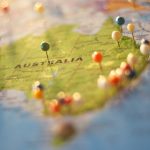Whiff of Success: The Intriguing Tale of Sandalwood
Warren Reed | January 5, 2011
The Australian newspaper’s new business magazine, The Deal, in its December issue, ran an interesting article by Victoria Laurie on one of Australia’s newest exports. It’s the story of a sandalwood oil distillation factory in Albany, in the southwestern corner of Australia, with the tantalising name of Mount Romance.
Owned by TFS (Tropical Forest Products) Corporation, a publicly listed Perth company, it is one of few such distilleries in the world and according to federal government projections, may be providing more than half of global demand in little more than a decade.
Australia has long been endowed with entrepreneurial ingenuity and the TFS operation is a good example.
While sandalwood, and the oil derived from it, has little resonance for Australians, it is fundamental to the cultures and religions of Asia, from India to Japan. The scent of smouldering joss sticks is one of the first sensations that visitors to the region encounter. The oil is used in a variety of ceremonies and the wood itself for religious and other artefacts. But where Mount Romance’s success has come from is in the role that sandalwood oil plays in the perfume industry as a key aromatic fixative.
The Albany factory currently exports 20 tonnes of refined oil annually to customers in the US and Europe. It has two sources of supply from remote parts of Western Australia: one from TFS’s irrigated plantations of shrubby Indian sandalwood trees in the Ord River region of the Kimberley’s far north, and the other, from gangly bushes of the native species found across the desert a thousand kilometres northeast of Perth. For the latter, the company relies on Aboriginal cutters. It is not an easy product to handle, as the valuable heart of the tree is nearer the root.
Ironically, India, which for centuries had been the traditional provider of sandalwood, and which has seen its stands of the timber decimated by over-harvesting, may end up being Australia’s key export market. To ease the plight of the Indians, one of TFS’s major shareholders and the company’s global ambassador – former Test cricketer Adam Gilchrist – has visited the worst affected villages to help with aid for welfare and education.
The article in The Deal magazine points out that, “Australian sandalwood oil has been crudely distilled since the early 1900s, and the wood was one of the nation’s biggest early exports. Sandalwood harvests peaked in the 1920s, at more than 14,000 tonnes, to meet a strong Chinese demand. That prompted the WA government to restrict harvests, and licences are still limited.”
Actually, much more history lies behind this, and it was played out on the other side of the continent. It is yet another illustration of how Australia’s early entrepreneurial flair is rarely, if ever planted in our consciousness at an early age.
One of the country’s great sandalwood traders was Captain Edward Woodin (no pun intended) who regularly visited the islands of the Western Pacific in the 1840s and 50s from Hobart Town. He was a man noted among colonial mariners for his intelligence and wisdom.
Sandalwood had long been imported by China for use, not only in Buddhist temples and on ceremonial occasions, but also in the manufacture of boxes, ornaments, fans, medicines and cosmetics. Historically, supplies going to China, where the wood was not grown, came from the Malabar and Coromandel coasts of India and some, later, from Portuguese possessions in the Spice Islands, especially from Timor.
In the first quarter of the 19th century there had been three sandalwood ‘rushes’ in the Pacific, with the Americans in the vanguard of each. These had centred on the Fijian Islands, the Marquesas, and the Hawaiian Islands. In 1834, however, when the monopoly of the British East India Company on the shipment of Australian colonial merchandise was broken, Sydney and Hobart Town merchants looked for new trading opportunities in the region, especially in China. Pearl shell, tortoiseshell, bêche-de-mer, as well as kauri pine and cedar, were early Australian experiments. But sandalwood stood out as the prime money-earner.
Then, in 1841, a London Missionary Society ship visited the Australian colonies after a voyage through the South Sea Islands, and ‘let the cat out of the bag’: stands of sandalwood had been seen in the New Hebrides and on the Isle of Pines, off the southern tip of New Caledonia. At the time, these islands were virtually unknown, having been deliberately ignored because of stories of dangerous fevers and ferocious warriors with a predilection for cannibalism. But with sandalwood’s reputation as a source of quick wealth, the fourth and final sandalwood rush was under way. Captain Andrew Cheyne, sailing out of Sydney, and Woodin from Hobart, were two of the main entrepreneurs involved. Both are unsung heroes of Australia’s early trading heritage.
Woodin first appears in Tasmania’s maritime history in 1834 when, at the age of 33, he was listed as the trading master of a small brig sailing out of Hobart. His first voyage to New Caledonia came in 1842 as master of the Caroline, which had been fitted out in 1829 as Tasmania’s first offshore whaler. He and his crew spent around four months in the islands, bartering axes, tomahawks and muskets with the natives for supplies of sandalwood, as well as tortoiseshell. Needless to say, this was a delicate and dangerous undertaking, with this period in Australia’s history producing some truly bloodcurdling tales. Woodin took his cargo up to the China coast.
In 1843-44, he made another similar voyage, this time as captain of the Hobart Town barque, William IV. In 1845, he was off again, returning from China in 1846 with a cargo of tea and sugar from Amoy (now known as Xiamen). In the middle of that same year, he was given command of the barque, Eleanour, in which he traded until 1853. During these years, Woodin moved almost continuously between Hobart, the Islands, Hong Kong and the China coast. He was often accompanied by the brig, Spy, with the two vessels becoming known as the ‘Hobart Town pair’. During his numerous voyages through the Western Pacific, he systematically explored and mapped the area. In 1847, he discovered a crucial sea passage that saved foreign vessels much tedious sailing time. It is still known to this day as ‘Woodin’s Channel’.
High quality tea, brown sugar, silks and other materials, fireworks, preserves, lacquer-ware, camphorwood trunks and toys were common cargoes on the return voyages from China. It is interesting to note that in mid-1850, Woodin was taking on board 150 chests of opium in Hong Kong. Then, a few weeks later, he appears in Amoy, further along the China coast, loading large quantities of sugar, which were presumably for the Sydney and Hobart Town markets. We do not know whether the opium that he had onboard was off-loaded in Amoy, nor whether some of it found its way back to the Australian market, where dens were not unknown.
Woodin died at sea in 1866 on board a Dutch ship, while travelling as a passenger from Batavia (modern-day Jakarta) to Melbourne. A number of his logbooks exist, as do articles he had published in nautical magazines, but his personal journals seem to have disappeared. They would indeed have a story to tell.
Captain Andrew Cheyne pointed to the dangers the sandalwood traders faced when his book, A Description of Islands in the Western Pacific Ocean, was published in London in 1852. He explains how the captain of the brig Star in 1842 was parlaying with the natives of the Isle of Pines for sandalwood. Uncharacteristically, he allowed the king’s son and some thirty men to come on board, who immediately requested that payment be made in axes. When this was done, the natives asked that the axes be sharpened for them, after which they mixed amicably with the crew, two of them stationing themselves behind the captain. “Suddenly,” Cheyne writes, “and without a moment’s warning, the signal was given, and the unfortunate captain was cut down by a blow from behind – his skull being actually divided by the force of the axe – and the whole of the crew of sixteen, with the exception of the mate and some native missionaries from the Navigator Islands, were massacred.”
The vessel was then hauled into shallow water and partly dismantled, with the bodies taken ashore for roasting and eating. A large group of natives was standing on the quarterdeck when the ship was eventually set alight and when a store of gunpowder in the hold exploded they were all killed.
Stories like this were not uncommon and the reason for crews being tricked and murdered was often in revenge for the appalling way in which some of the sandalwooders and whalers treated the natives of the Islands. The depredations of escaped convicts from New South Wales, who were hiding out in the region also contributed to such displays of vengeance.
As ever, history is replete with both the fascinating and the unpalatable, but it is always worth knowing.
For further reading on this subject the meticulous writings of the late Australian academic, Dorothy Shineberg, are highly recommended, especially her book, They Came for Sandalwood: A Study of the Sandalwood Trade in the South-West Pacific, 1830-1865, Melbourne University Press, 1967. She also wrote on the trading voyages of Andrew Cheyne, 1841-1844.
____________________________________________
Warren Reed is a former intelligence officer whose first whiff of sandalwood came from joss sticks in Japanese temples when he was studying in the Law Faculty of Tokyo University in the 1970s.
SHARE WITH:
















peter brady
February 15, 2011 at 6:29 am
see comment on asia earlier article
see comment on asian article